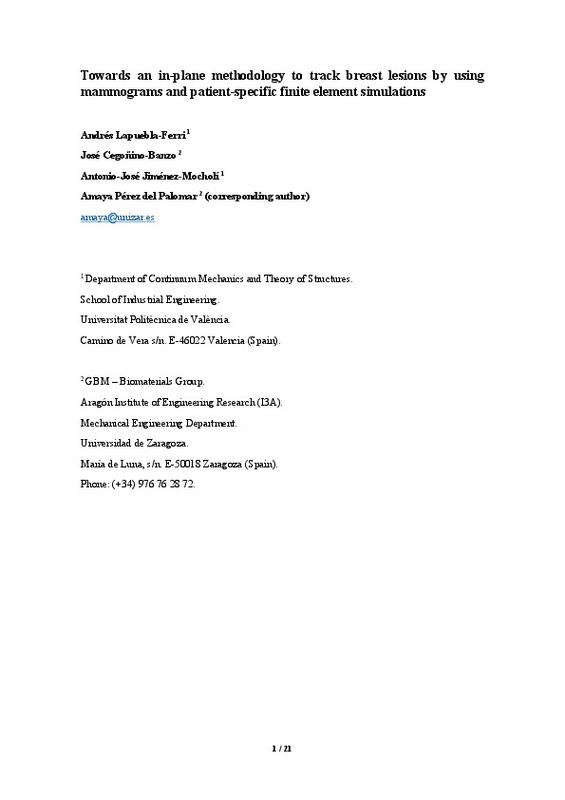JavaScript is disabled for your browser. Some features of this site may not work without it.
Buscar en RiuNet
Listar
Mi cuenta
Estadísticas
Ayuda RiuNet
Admin. UPV
Towards an in-plane methodology to track breast lesions using mammograms and patient-specific finite-element simulations
Mostrar el registro sencillo del ítem
Ficheros en el ítem
| dc.contributor.author | Lapuebla-Ferri, Andrés
|
es_ES |
| dc.contributor.author | Cegoñino-Banzo, José
|
es_ES |
| dc.contributor.author | Jimenez Mocholi, Antonio José
|
es_ES |
| dc.contributor.author | Perez del Palomar, Amaya
|
es_ES |
| dc.date.accessioned | 2019-02-17T21:03:41Z | |
| dc.date.available | 2019-02-17T21:03:41Z | |
| dc.date.issued | 2017 | es_ES |
| dc.identifier.issn | 0031-9155 | es_ES |
| dc.identifier.uri | http://hdl.handle.net/10251/116794 | |
| dc.description.abstract | [EN] In breast cancer screening or diagnosis, it is usual to combine different images in order to locate a lesion as accurately as possible. These images are generated using a single or several imaging techniques. As x-ray-based mammography is widely used, a breast lesion is located in the same plane of the image (mammogram), but tracking it across mammograms corresponding to different views is a challenging task for medical physicians. Accordingly, simulation tools and methodologies that use patient-specific numerical models can facilitate the task of fusing information from different images.Additionally, these tools need to be as straightforward as possible to facilitate their translation to the clinical area. This paper presents a patient-specific, finite-element-based and semi-automated simulation methodology to track breast lesions across mammograms. A realistic three-dimensional computer model of a patient¿s breast was generated from magnetic resonance imaging to simulate mammographic compressions in cranio-caudal (CC, head-to-toe) and medio-lateral oblique (MLO, shoulder-to-opposite hip) directions. For each compression being simulated, a virtual mammogram was obtained and posteriorly superimposed to the corresponding real mammogram, by sharing the nipple as a common feature. Two-dimensional rigid-body transformations were applied, and the error distance measured between the centroids of the tumors previously located on each image was 3.84 mm and 2.41 mm for CC and MLO compression, respectively. Considering that the scope of this work is to conceive a methodology translatable to clinical practice, the results indicate that it could be helpful in supporting the tracking of breast lesions. | es_ES |
| dc.description.sponsorship | This work was supported by the Spanish Ministry of Economy and Competitiveness through project DPI 2016-79302-R. The authors declare that there are no conflicts of interest. | en_EN |
| dc.language | Inglés | es_ES |
| dc.publisher | IOP Publishing | es_ES |
| dc.relation.ispartof | Physics in Medicine and Biology | es_ES |
| dc.rights | Reserva de todos los derechos | es_ES |
| dc.subject | Breast biomechanics | es_ES |
| dc.subject | Finite element model | es_ES |
| dc.subject | Large deformations | es_ES |
| dc.subject | Image registration | es_ES |
| dc.subject | Contact problem | es_ES |
| dc.subject.classification | MECANICA DE LOS MEDIOS CONTINUOS Y TEORIA DE ESTRUCTURAS | es_ES |
| dc.title | Towards an in-plane methodology to track breast lesions using mammograms and patient-specific finite-element simulations | es_ES |
| dc.type | Artículo | es_ES |
| dc.identifier.doi | 10.1088/1361-6560/aa8d62 | es_ES |
| dc.relation.projectID | info:eu-repo/grantAgreement/MINECO//DPI2016-79302-R/ES/DISEÑO DE TRATAMIENTOS Y SISTEMAS PROTESICOS PARA LA CORRECCION TEMPRANA DE ASIMETRIAS MANDIBULARES EN NIÑOS. APROXIMACION NUMERICO-EXPERIMENTAL/ | |
| dc.rights.accessRights | Abierto | es_ES |
| dc.contributor.affiliation | Universitat Politècnica de València. Departamento de Mecánica de los Medios Continuos y Teoría de Estructuras - Departament de Mecànica dels Medis Continus i Teoria d'Estructures | es_ES |
| dc.description.bibliographicCitation | Lapuebla-Ferri, A.; Cegoñino-Banzo, J.; Jimenez Mocholi, AJ.; Perez Del Palomar, A. (2017). Towards an in-plane methodology to track breast lesions using mammograms and patient-specific finite-element simulations. Physics in Medicine and Biology. 62(22):8720-8738. https://doi.org/10.1088/1361-6560/aa8d62 | es_ES |
| dc.description.accrualMethod | S | es_ES |
| dc.relation.publisherversion | https://doi.org/10.1088/1361-6560/aa8d62 | es_ES |
| dc.description.upvformatpinicio | 8720 | es_ES |
| dc.description.upvformatpfin | 8738 | es_ES |
| dc.type.version | info:eu-repo/semantics/publishedVersion | es_ES |
| dc.description.volume | 62 | es_ES |
| dc.description.issue | 22 | es_ES |
| dc.relation.pasarela | S\347070 | es_ES |
| dc.contributor.funder | Ministerio de Economía y Competitividad |







![[Cerrado]](/themes/UPV/images/candado.png)

